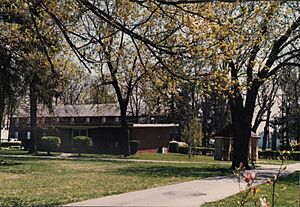Camp Chesterfield facts for kids
Quick facts for kids |
|
|
Chesterfield Spiritualist Camp District
|
|

Historic Camp Chesterfield
|
|
| Location | 50 Lincoln Drive, Chesterfield, Indiana |
|---|---|
| Area | 34.9 acres (14.1 ha) |
| Built | 1886 |
| Architectural style | Late 19th And Early 20th Century American Movements, Art Deco |
| NRHP reference No. | 02000192 |
| Added to NRHP | July 17, 2002 |
Camp Chesterfield is a special place in Chesterfield, Indiana. It was started in 1891 and is the main home for the Indiana Association of Spiritualists.
At Camp Chesterfield, people can attend Spiritualist Church services. They can also take classes to learn about mediumship (communicating with spirits), faith healing, and general spiritual growth. The camp also offers psychic readings to visitors.
In 2002, the camp was recognized as a historic district. It was added to the National Register of Historic Places as the "Chesterfield Spiritualist Camp District." This means it is an important historical site.
History of Camp Chesterfield
Camp Chesterfield has a long history, and over the years, some people have had questions about its practices.
In 1925, some people raised concerns about how the camp's mediums conducted their sessions. This led to investigations into their activities.
Later, in 1960, a researcher named Andrija Puharich and a magazine publisher tried to film two seances at the camp. They used special infrared film to see if they could get scientific proof of spirits appearing. The medium knew she was being filmed. However, the film later raised questions about whether the spirit appearances were real.
A writer named Allen Spraggett visited the camp in 1965. He also had doubts about the spirit appearances during seances. He found them hard to see and thought they sounded just like the medium. He felt the demonstrations were not convincing.
In 1976, a former medium named M. Lamar Keene wrote a book called The Psychic Mafia. In this book, he shared how some mediums might create illusions. He described methods that could make it seem like spirits were present. Keene and Spraggett wrote that information about visitors, like names of loved ones, was sometimes collected during services. They suggested this information might have been shared among mediums. This could have allowed mediums to seem like they knew personal details about visitors.
A story in Fate magazine told of a couple who visited the camp after losing their child. They hoped to contact their child. They were asked to write down names of those they wished to contact. Along with their child's name, they added two made-up names of relatives. Later, during a seance, these two made-up relatives supposedly appeared and spoke to them. This made the couple question what was happening.
In 2002, a skeptical investigator and former magician named Joe Nickell also performed an investigation at Camp Chesterfield. He published his findings in The Skeptical Inquirer magazine, which further raised questions about the practices of some mediums at the camp.
A Historic Place
Camp Chesterfield was added to the National Register of Historic Places because it is a great example of a Spiritualist Camp. These types of camps were common in the eastern and Midwestern United States in the early 1900s.
These camps usually had a common public area in the middle. Homes were built closely around this central space. When Camp Chesterfield started in 1890, it had simple tents and wooden summer cabins. There were also shared buildings like a dining hall and a place for meetings. None of these original structures are still standing today.
As the Spiritualist movement grew, more permanent buildings were added. These included a church, a meeting house, and homes. Many of these buildings still exist, including a two-story hotel built in 1914. The camp continued to grow after World War II. A new hotel was built in 1949, a cathedral in 1954, and an art gallery in 1958.
The historic site includes many different parts. There are 40 buildings, 9 structures, and 2 objects that contribute to its historical importance. The structures include stone bridges and a stone sweathouse. The objects are a Native American memorial and a totem pole.




